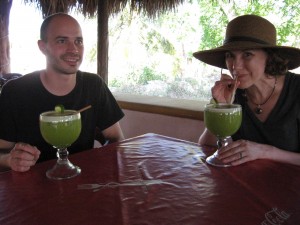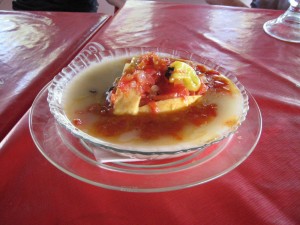Driving across the peninsula from west to east, from the Mayan ruins of Uxmal to the small resort town / Mayan ruin of Tulum, we decided to take the secondary roads rather than the main highway, which I particularly loved because it was my first glimpse of what I have always imagined “small-town Mexico” to look like – very modest little homes, most of them made of cement with tin roofs but a surprising number in this part of the country still made of stick walls with a thatch roof; lots of small stores selling groceries or fruit juices or shoes or cell phone accessories; lots of people, young and old, most of them of Mayan descent, wandering around in t shirts and shorts and flip flops, chatting with each other or casually eyeing our big white mini van.
In the dusty, seemingly forgettable little town of Jose Maria Morelos we stopped at random at a roadside café with a large outdoor terrace just to stretch our legs and get a break from the driving. We have been having incredible luck with food so far, with great meal after great meal seemingly by accident, but this seemed like a pretty run-of-the-mill place so we were just thinking we’d get drinks and be on our way. We left about 2 hours later, having filled ourselves on two regional dishes we hadn’t even heard of – an entire ball of locally made Edam cheese stuffed with ground beef and tomato sauce, and a plate of shredded deer meat mixed with a basic salsa and served with corn tortillas – plus pineapple smoothies blended with a local herb (chaya).
Why did we stay so long? Well one reason was that the food was so interesting and tasty and led us to linger, but the other is that Jessica Lopez, the woman who ran the café, was extremely eager to chat with us about her establishment and how it played into the larger question of regional economic development. Towns like Cancun and Tulum have no trouble spurring economic growth – in fact their problem is trying to contain it – but not so the little backwaters like Jose Maria Morelos. As the extremely friendly Jessica explained, her town receives few tourists – mostly Mexicans transporting goods between several major towns – and as a result the economy languishes. It has no beach and seemingly no major industry, and so a little restaurant like her “Kilometer 50” languishes too. She mentioned a few ideas that seemed fitting and a few that surprised us – trying to turn the town into more of a “green” or eco site; increasing ties between a small university nearby and an American university that would bring students and American professors to the town; building a “Mexican Disneyland” possibly with a fake beach; and trying to attract small factories producing textiles or electronids for foreign companies (these maquiladores are very common in Mexico, especially along the US border). I’ll let you guess which seemed fitting and which were surprising to us.
It’s an interesting dilemma that took similar forms at other points in our trip. How do you spur economic growth so that it ripples out through an entire town, benefitting many local families, while staying true to ecological or ethical or cultural-authenticity principles? How should Jessica market her restaurant so that it stays afloat? Should she cater to the few tourists that pass through or to the many more Mexican travelers? And if she tries to lure tourists, what is the best route? As an eco-café? A purveyor of local or organic food? Regional cuisine? Mexican cuisine? Mayan specialties?
The fun thing for us was that she actually asked our advice as to what should go on an English-language sign out by the road to attract tourists. Here are some variations we came up with:
- “Authentic Mayan Cuisine”
- “Traditional Mayan Cuisine”
- “Specializing in Regional Dishes”
- “Local Specialities”
and the more prosaic:
- “Fresh Fruit Juices”
- “Mineral Water”
Her reaction to some of our suggestions was very indicative of the differences in the perceptions of travel by outside tourists and locals. She was puzzled by our emphasis on local or regional cuisine – she said she was more inclined to emphasize that she featured “Mexican” cuisine, whereas we were trying to convince her that what well-to-do Americans seek out these days is something more localized, more “authentic.” She was also puzzled by our emphasis on mineral water, because in her mind it was merely some product made by Coca Cola, but in our minds when you are traveling in a foreign country mineral water takes on this aura of refreshment and purity (read: clean and sanitary) that ordinary bottled water may not.
For this brief moment we were thrust into the role of tourism consultants, and it embodied many of the tensions we have been grappling with since we arrived. Who is tourism for, the tourist or the toured? Whose values should be emphasized? Whose tastes should be on display? And what kind of a balance should a little town like Jose Maria Morelos try to strike between tourism and a more indigenous and resilient form of development?






